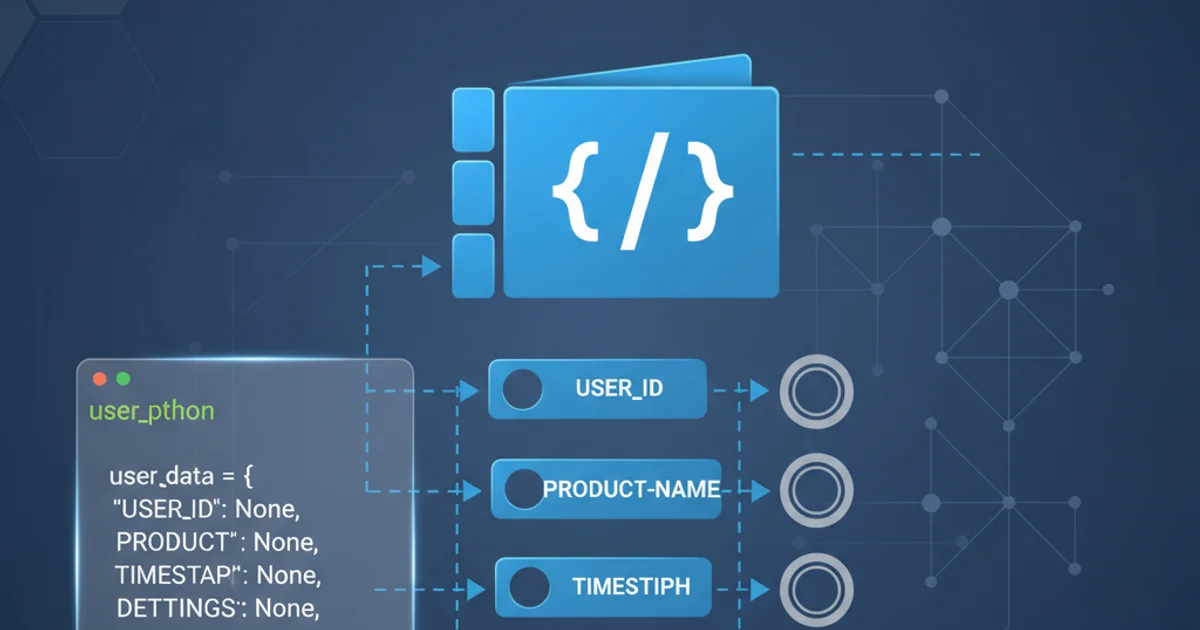Initializing a dictionary in python with a key value and no corresponding values
Categories:
Initializing Python Dictionaries with Keys and No Values

Learn various Pythonic ways to create dictionaries where keys are present but their corresponding values are initially undefined or set to a default placeholder.
Initializing a dictionary in Python with keys but no immediate corresponding values is a common task. This scenario often arises when you know the structure or the set of keys your dictionary will eventually hold, but the actual data for those keys will be populated later. Python offers several elegant and efficient ways to achieve this, ranging from simple loops to more concise built-in functions.
Why Initialize with Keys but No Values?
There are several practical reasons why you might want to initialize a dictionary in this manner:
- Schema Definition: You might be defining a data structure or schema where certain keys are guaranteed to exist, even if their initial content is empty.
- Placeholder for Future Data: When processing data in stages, you might first identify all unique identifiers (keys) and then populate their associated data (values) in a subsequent step.
- Counting/Aggregation: For tasks like counting occurrences, you might pre-populate keys and then increment their values as items are encountered.
- Avoiding KeyErrors: By ensuring keys exist from the start, you can prevent
KeyErrorexceptions when attempting to access or update values later, especially if you're using methods that don't automatically add keys (e.g.,dict[key] = valuevs.dict.get(key, default)).
flowchart TD
A[Start: Identify Required Keys] --> B{Choose Initialization Method}
B --> C{Method 1: Loop}
B --> D{Method 2: `dict.fromkeys()`}
B --> E{Method 3: Dictionary Comprehension}
C --> F[Iterate through keys, assign default value]
D --> G[Use `dict.fromkeys(keys, default_value)`]
E --> H[Create `{key: default_value for key in keys}`]
F --> I[Result: Dictionary with keys and default values]
G --> I
H --> I
I --> J[End: Dictionary Ready for Value Population]Workflow for initializing a dictionary with keys and default values.
Common Initialization Methods
Let's explore the most common and Pythonic ways to initialize a dictionary with keys and a default value (or None).
None, 0, [], {}) depends heavily on the intended use case for the dictionary. Be mindful of mutable default values like lists or dictionaries, as they can lead to unexpected behavior if not handled carefully.1. Using dict.fromkeys()
The dict.fromkeys() class method is specifically designed for this purpose. It takes an iterable of keys and an optional value. If the value is not provided, it defaults to None.
# Using a list of keys
keys_list = ['name', 'age', 'city']
my_dict_none = dict.fromkeys(keys_list)
print(f"With None: {my_dict_none}")
my_dict_default_value = dict.fromkeys(keys_list, 0)
print(f"With default 0: {my_dict_default_value}")
# Using a tuple of keys
keys_tuple = ('product_id', 'price')
my_dict_tuple = dict.fromkeys(keys_tuple, 'N/A')
print(f"With 'N/A': {my_dict_tuple}")
Initializing dictionaries using dict.fromkeys() with None and a custom default value.
dict.fromkeys() with a mutable default value (e.g., a list or another dictionary), all keys will point to the same instance of that mutable object. Modifying the value for one key will affect all other keys. For independent mutable values, use a dictionary comprehension.2. Using Dictionary Comprehension
Dictionary comprehensions provide a concise and readable way to create dictionaries. They are particularly powerful when you need to apply a transformation to keys or values, or when you need independent mutable default values.
keys = ['item_a', 'item_b', 'item_c']
# Initialize with None
my_dict_comp_none = {key: None for key in keys}
print(f"Comprehension with None: {my_dict_comp_none}")
# Initialize with an empty list (each key gets a new list)
my_dict_comp_list = {key: [] for key in keys}
print(f"Comprehension with empty list: {my_dict_comp_list}")
# Demonstrate independent lists
my_dict_comp_list['item_a'].append(1)
my_dict_comp_list['item_b'].append(2)
print(f"After appending: {my_dict_comp_list}")
Initializing dictionaries using dictionary comprehension, including independent mutable values.
3. Using a Simple Loop
For straightforward cases or when you prefer explicit iteration, a simple for loop can also be used to populate the dictionary. This method is very clear and easy to understand, especially for beginners.
keys = ['user_id', 'email', 'status']
my_dict_loop = {}
for key in keys:
my_dict_loop[key] = 'pending'
print(f"Loop initialized: {my_dict_loop}")
Initializing a dictionary using a basic for loop.